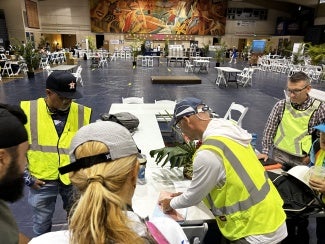
Using SAP training to aid recovery after the Lahaina wildfires
Lorena Yamamoto, AIA, on the rewards of aiding in disaster assistance after wildfires in Hawai'i.
When the wildfire tore through Lahaina, a small community on the island of Maui, Hawai’i, in August of 2023, it left a scar on the community that will take years, if not decades, to heal.
As an architect living in Hawaiʻi, I’ve always felt a deep responsibility toward the built environment, but nothing prepared me for the devastation I witnessed firsthand in the aftermath of the Lahaina fire. I joined the Safety Assessment Program (SAP) to help evaluate the structural integrity of buildings, offering a small yet significant way to support those affected by the disaster. What struck me most during this time was the powerful presence of the aloha spirit—a Hawai’ian spirit of compassion, unity, and resilience that infused every aspect of the recovery efforts. Here are my top five takeaways from the experience—lessons that I hope will inspire other architects to get involved with SAP.
Get SAP certified now.
One of the first things I realized after the Lahaina fire was the importance of being prepared. AIA Hawaiʻi State Council was fortunate enough to mobilize SAP certification training quickly—just one week after the disaster on August 8. In an incredible show of dedication, 70 architects and engineers were certified in this emergency training session, all eager to lend their expertise to the recovery efforts. However, this isn’t something you should count on in every situation. Getting SAP certified ahead of time ensures you’re ready to help immediately when a disaster strikes. It’s better to be prepared and ready to deploy than to scramble in the aftermath of a crisis. AIAU partners with CalOES (the California Office of Emergency Services), which runs the nationwide SAP program. You can find the latest opportunities for training and certification through your local chapter, virtually on AIAU.aia.org, or CalOES’s website.
Understand the importance of professional liability.
While SAP work is fundamentally rooted in goodwill, it’s still crucial to be mindful of potential liabilities. Like many others, I initially worried about the consequences of signing off on a structure’s safety. What if something went wrong? These concerns are valid, but they shouldn’t deter you from participating. Thankfully, our chapter took proactive steps by drafting a Memorandum of Understanding (MOU) with our State Emergency Management Agency (HI-EMA), which led to the enactment of an emergency statute providing professional immunity for this service. If your chapter hasn’t already addressed this, it’s a step worth considering sooner rather than later.
Prepare for delays and bureaucratic challenges.
The road to providing assistance isn’t always straightforward. One of the challenges we faced was the delay in our deployment due to the time it took to finalize the MOU. As a result, we weren’t able to begin our work until nearly two months after the fire, which limited our ability to provide timely assistance. By the time we arrived, many CalOES workers had been on the ground for over a month, visibly exhausted and emotionally drained. These bureaucratic hurdles can be frustrating, but they are also an important reminder of the complexities involved in disaster response. Preparing for these challenges ahead of time can make a significant difference in how quickly you can assist.
Find fulfillment in helping your community.
In Hawaiʻi, we often talk about the concept of mālama—caring for and protecting one another. We often feel helpless in the face of disasters, resorting to donating money or supplies to relief efforts. While these contributions are vital, being directly involved in SAP work offers and unparalleled sense of fulfillment. There’s something profoundly rewarding about using your skills to help those in need, offering a tangible way to give back to your community. For me, being on the ground in Lahaina, assessing damaged structures, was one of the most meaningful experiences of my career. It was also deeply fulfilling to work alongside colleagues in my profession, united by a common cause and the shared desire to help our community in its time of need.
Prepare for a life-changing experience.
No amount of training could have prepared me for the sheer devastation I witnessed in Lahaina. The destruction was overwhelming, and at times, it felt surreal. Yet amidst this devastation, the aloha spirit was ever-present, binding the community together in an incredible display of resilience and unity. This experience forced me to confront the fragility of our built environment and made me deeply grateful for the safety and stability I often take for granted. It was a life-changing experience that underscored the critical role architects can play in disaster recovery and the importance of being ready to act when needed.
Building resilience through action
My experience with the Safety Assessment Program in Lahaina was both challenging and transformative. It reinforced the importance of being prepared, the value of professional liability protections, and the fulfillment that comes from directly helping those in need. Most importantly, it reminded me of the profound impact architects can have in times of crisis, particularly in a community where the aloha spirit runs deep. I encourage every architect to get involved with SAP, get certified, and be ready to lend a hand when it matters most. In doing so, you’ll not only be helping others but also embracing the true essence of aloha–caring for and protecting our communities.
Lorena Yamamoto, AIA, is an architect in Honolulu County, Hawaii.
AIA's next training for the Safety Assessment Program will be held virtually December 11-12.
